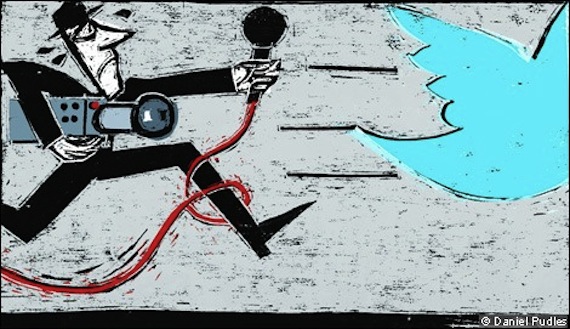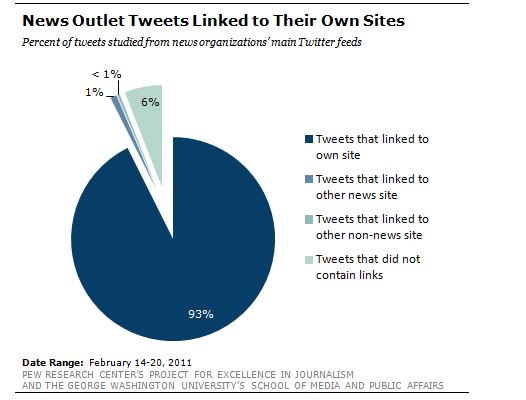
Most major news organizations have embraced the need to incorporate social media, especially Twitter, into their broadcasting of current and breaking coverage. But just as the mainstream media gains their comfort in tweeting content, very few have learned to engage or garner feedback from their expansive audience.
That is one of the findings from The Pew Research Center‘s Project for Excellence in Journalism and The George Washington University’s School of Media and Public Affairs joint study released Monday about the Twitter behavior of the mainstream media.
Self-promotional tweets
From the 13 major organization followed and the more than 3,600 tweet examined through the course of a week, it became clear that the media was great and promoting articles they wrote, but they did little to start a dialogue with their audience. The organizations examined were The Washington Post, The New York Times, USA Today, The Wall Street Journal, Arizona Republic, The Toledo Blade, NPR, CNN, Fox News, MSNBC, ABC News, Huffington Post and Daily Caller.

Pew found that 93% of the tweets examined linked to the organizations own articles or website. Then, only 6% linked to non-news website and a mere 1% linked to other news organization websites and less than 1% of tweets contained no links at all.
For a platform that touts its ability to connect people across the world and receive real-time feedback, these results show that mainstream news outlets have only grasped a limited way to use Twitter.
Journalists tool versus news distribution
I follow dozens of reporters from some of these news organizations, and they, for the most part, are far more interactive and engaging than their parent Twitter accounts. Part of the appeal of following people on Twitter is the knowledge that you can reply and create a conversation with the source of an article — but organizations are less responsive than journalists to this level of engagement.
Pew, however, found that the 13 most-followed journalists in the mainstream media examined, only retweeted outside content 6% of the time and solicited information from the public only 3% of the time.
Many journalists on the platform, at least the one’s I follow, use Twitter as a reporting tool to ask their hundreds or hundreds of thousands of followers questions about a topic or even post a request for tour guides or housing for their next abroad mission. These are valuable assets that news organizations could garner, if they loosen their focus a bit.
There are challenges with opening up the content they share and post on social media, since all mainstream news organizations have codes of conduct and ethics they need to follow to limit bias, but I think that asking open-ended questions and requesting feedback on coverage would be great, unbiased, places to start.
This study also found that across all the platforms looked at (print, network TV, cable, online and radio), the number of Twitter feeds that a given organization had differed drastically from a single handle to the Washington Posts’ 98 specialized handles.
The number of tweets daily, per feed, also was a wide margin of fewer than 10 tweets to nearly 100. Despite these stark differences, the behavior was very similar across the board.
While the study only looked at a single week in February, which doesn’t give a very rich understanding of each group’s overall Twitter presence, it does show that news organizations should look at interaction more than simple links. It seems obvious that media groups would self-promote their orignial content, but the “old thinking” that you shouldn’t send your readers to outside sources is just that, old. Followers appriciate the best quality of content from the handles they follow and will return to sources that give them the richest experince — even if they are sharing outside sources.
It may take a lot more time for new organizations to loosen-up their tight view of what should be broadcast from a media source, especially when journalism authorities, such as AP, are taking stances against adding comments to retweets actioned by the media. It is challenging to utilize social media and evolve with your audince, when journalism institiutions seem slow to adopt change. Hopefully, a few new drafts of social media policy and some reign-pulling by the journalists and news audience will guide news organizations into a more interactive space online.
Image Sources — Socialogicmarketing.com and Amijournalist.blogspot.com


















